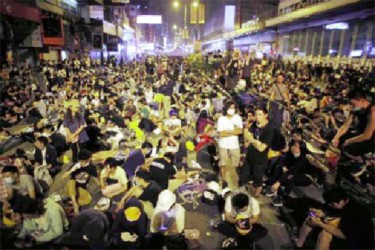HONG KONG, (Reuters) – A deepening sense of impasse gripped Hong Kong as pro-democracy protests entered their fourth week, with the government having limited options to end the crisis and demonstrators increasingly willing to confront police.

Dozens of people were reportedly injured in two nights of clashes that began late on Friday in the densely populated Mong Kok district of the Chinese-controlled city, including 22 police. Four people were arrested early yesterday, police said.
The area was calm early on Monday, although scores of protesters remained on the streets.
Hopes of easing the worst political crisis in Hong Kong since Britain handed the free-wheeling city back to China in 1997 rest on talks scheduled for Tuesday between the government and student protest leaders that will be broadcast live.
But few are expecting any resolution given the two sides are poles apart on how the city will elect its next leader in 2017.
“Unless there is some kind of breakthrough in … talks on Tuesday, I’m worried we will see the standoff worsen and get violent,” said Sonny Lo, a professor at the Hong Kong Institute of Education.
“We could be entering a new and much more problematic stage. I hope the government has worked out some compromises, because things could get very difficult now.”
Students want free elections, but China insists on screening candidates first. Hong Kong’s Beijing-backed leader, Leung Chun-ying, has said the city’s government was unwilling to compromise on China’s restrictions, which were announced in late August.
Leung, who has rejected calls by protesters to quit, said on Sunday that more time was needed to broker what he hoped would be a non-violent end to the upheaval.
“To work out a solution, to put an end to this problem, we need time. We need time to talk to the people, particularly young students,” he told Hong Kong’s ATV Television. “What I want is to see a peaceful and a meaningful end to this problem.”
Hong Kong’s 28,000-strong police force has been struggling to contain a youth-led movement.
Roughly 1,000 demonstrators in Mong Kok launched a fresh assault early on Sunday, putting on helmets and goggles before surging forward to grab a line of metal barricades hemming them into a section of road.
Scores of riot police had smashed batons at a wall of umbrellas that protesters raised to defend themselves. Amid shouts and hurled insults, scuffles erupted before police surged forward with shields, forcing the crowds back.
Last night, crowds again built up as protesters stockpiled helmets and fashioned homemade forearm shields out of foam pads to parry baton blows. Unlike previous nights, however, there were no clashes.
Besides Mong Kok, about 1,000 protesters remain camped out at the headquarters of the civil disobedience “Occupy” movement on Hong Kong Island in a sea of tents on an eight-lane highway beneath skyscrapers close to government headquarters.
RESTIVE GENERATION
The protesters, led by a restive generation of students, have been demanding China’s Communist Party rulers live up to constitutional promises to grant full democracy to the former British trading outpost.




